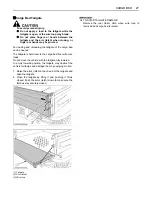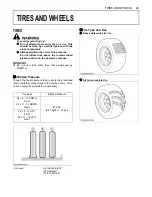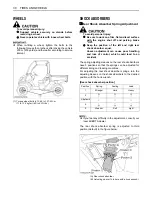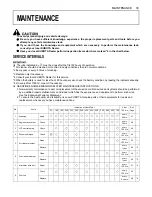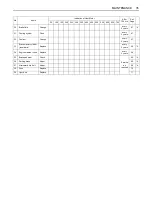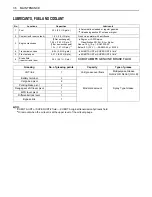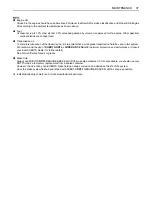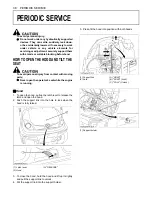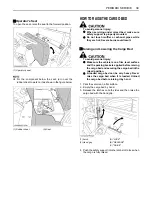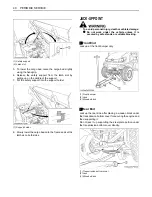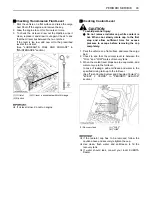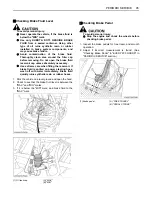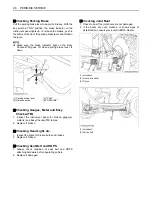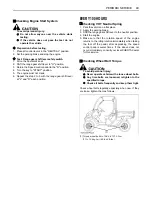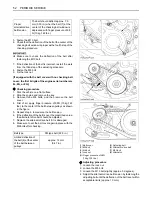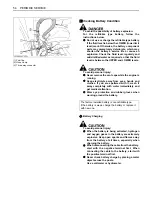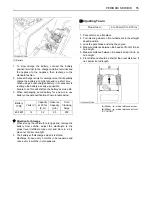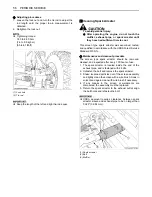
41
PERIODIC SERVICE
DAILY CHECK
For your own safety and maximum service life of the
vehicle, make a thorough daily inspection before
operating the vehicle to start the engine.
To avoid personal injury:
A
Be sure to check and service the vehicle on a
flat surface with the engine shut off and the
parking brake "ON".
B
Walk Around Inspection
Look around and under the vehicle for such items as loose
bolts, trash build-up, oil or coolant leaks, broken or worn
parts.
B
Checking Amount of Fuel and Refueling
To avoid personal injury:
A
Handle fuel carefully. If the engine is running,
do not fill the fuel tank. If engine is hot, let
engine cool several minutes before adding fuel.
Do not smoke while filling the fuel tank or
servicing the fuel system. Fill fuel tank only to
bottom of filler neck. Do not fill completely full.
The empty space in the tank allows gasoline to
expand, when it heats up. Never remove the
fuel tank cap or add fuel when the fuel tank is
hot.
Check the fuel level. Take care that the fuel tank does not
become empty.
A
Do not mix oil with gasoline.
Use only unleaded gasoline with an octane rating index of
87 or higher may be used.
A
Use fuel within approximately 30 days after purchase
to avoid deterioration in fuel quality, or add fuel
stabilizer to keep fuel fresh and stabilized.
A
Fuel blend differs from season to season for the best
seasonal engine performance. To prevent engine
performance troubles such as vapor lock or hard
starting, use fuel within the season in which the fuel is
purchased.
A
Infrequent use of the engine during a season can
make fuel stale in the fuel tank of the machine. Stale
fuel condition can cause engine performance troubles
by varnish and plugged carburetor components.
A
Seal the fuel storage container tightly and store it out
of sunlight and heat to prevent fuel degradation.
A
Condensation in the fuel tank may occur because of
various operating or environmental conditions. To
reduce condensation and avoid affecting machine
operation, fill the fuel tank at the end of daily operation
and store fuel in the plastic container.
A
Use only an approved fuel container. Use only non-
metal, portable fuel containers approved by the
Underwriter's Laboratory (U.L.) or the American
Society for Testing & Materials (ASTM). If using a
funnel, make sure it is plastic and has no screen or
filter.
A
Never remove the fuel tank cap or add fuel with the
engine running. Allow the engine to cool before
refueling.
A
Never add fuel to or drain fuel from the machine
indoors. Move the machine outdoors and provide
adequate ventilation.
A
Clean up spilled fuel immediately. If fuel is spilled on
clothing, change clothing immediately. If fuel is spilled
near machine, do not attempt to start the engine but
move the machine away from the area of spillage.
Avoid creating any source of ignition until fuel vapors
have dissipated.
A
Never store the machine or fuel container where there
is an open flame, spark, or pilot light such as on a
water heater or other appliance.
A
Prevent fire and explosion caused by static electric
discharge. Static electric discharge can ignite fuel
vapors in an ungrounded fuel container.
A
Never fill containers inside a vehicle or on a truck or a
trailer bed with a plastic liner. Always place containers
on the ground away from your vehicle before fueling.
Fuel tank capacity
20 L (5.3 U.S.gals.)
Summary of Contents for RTV500
Page 13: ...5 SAFE OPERATION 1 Cardboard 2 Hydraulic line 3 Magnifying glass...
Page 14: ...SAFE OPERATION 6 7 DANGER WARNING AND CAUTION LABELS...
Page 15: ...7 SAFE OPERATION...
Page 16: ...SAFE OPERATION 8...
Page 18: ......

